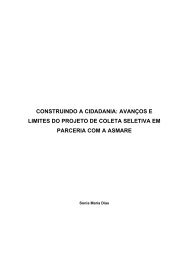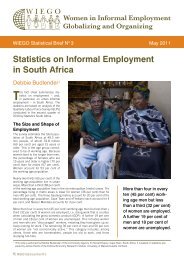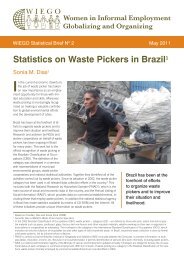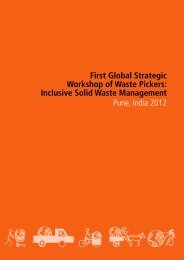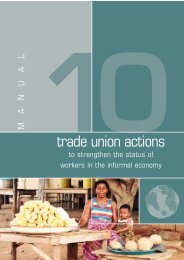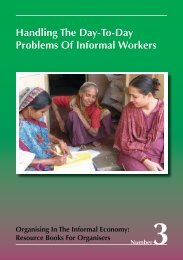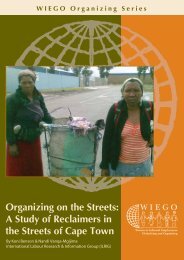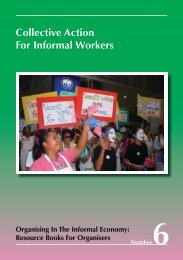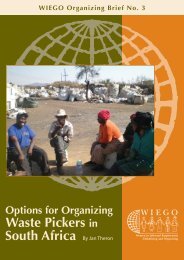Informal Economy Budget Analysis in Philippines and ... - WIEGO
Informal Economy Budget Analysis in Philippines and ... - WIEGO
Informal Economy Budget Analysis in Philippines and ... - WIEGO
Create successful ePaper yourself
Turn your PDF publications into a flip-book with our unique Google optimized e-Paper software.
<strong>WIEGO</strong> Work<strong>in</strong>g Paper N o 12Table of ContentsIntroduction.............................................................................................................................................1Objectives of the study.........................................................................................................................1Methodology <strong>and</strong> limitations.................................................................................................................1Overview of the <strong>Informal</strong> Workers <strong>in</strong> the Philipp<strong>in</strong>e <strong>Economy</strong>..................................................................2Amidst cont<strong>in</strong>u<strong>in</strong>g crisis <strong>and</strong> worsen<strong>in</strong>g poverty....................................................................................2Jobless growth <strong>and</strong> the <strong>in</strong>formalisation of women’s work.......................................................................3From <strong>in</strong>formal sector to <strong>in</strong>formal economy............................................................................................5National <strong>Budget</strong> Policy <strong>and</strong> the Philipp<strong>in</strong>e Development Agenda ...........................................................6The Philipp<strong>in</strong>e budget process.............................................................................................................6The Philipp<strong>in</strong>e development agenda ....................................................................................................7<strong>Budget</strong><strong>in</strong>g for Anti-poverty Reforms: Focus <strong>and</strong> Priorities......................................................................10Government l<strong>in</strong>e agencies champion<strong>in</strong>g pro-poor programmes <strong>and</strong> target<strong>in</strong>g workers <strong>in</strong>the <strong>in</strong>formal economy.....................................................................................................................11Poverty reduction projects subsidised by tax w<strong>in</strong>dfall..........................................................................18The Local Context: Quezon City’s Local <strong>Budget</strong> Policies <strong>and</strong> Programmes Relevant to its<strong>Informal</strong> <strong>Economy</strong> Workers ....................................................................................................................19Quezon City’s l<strong>and</strong> area <strong>and</strong> population..............................................................................................20The Plight of the poor <strong>and</strong> the <strong>in</strong>formal economy workers <strong>in</strong> Quezon City............................................20Address<strong>in</strong>g poverty <strong>in</strong> Quezon City .....................................................................................................21Help<strong>in</strong>g poor women through the Sikap Buhay Entrepreneurship <strong>and</strong> Microf<strong>in</strong>ance Programme ............22Livelihood support for the waste-pickers <strong>in</strong> the Payatas dumpsite .......................................................23Programmes <strong>and</strong> strategies address<strong>in</strong>g the needs <strong>and</strong> prevail<strong>in</strong>g issues, concerns <strong>and</strong>challenges of women workers <strong>in</strong> the <strong>in</strong>formal economy...................................................................24Programmes of non-government organisations <strong>and</strong> people’s organisations for workers<strong>in</strong> the <strong>in</strong>formal economy................................................................................................................ 28Compell<strong>in</strong>g Government <strong>Budget</strong>s to Address Practical Needs <strong>and</strong> Strategic Goals................................30Summary <strong>and</strong> Conclusion.......................................................................................................................31Abbreviations.........................................................................................................................................32References.............................................................................................................................................35Resource Persons...................................................................................................................................38List of TablesTable 1: Percentage Distribution of Expenditure Programme by Sector, 2000–2008................................10Table 2: Government Agencies Promot<strong>in</strong>g Projects for the Poor <strong>and</strong> <strong>Informal</strong> Sector, 2007–2009............12Table 3: Programmes Supportive of MDG Targets Funded By VAT for 2008.............................................18Table 4: Livelihood Programme for the <strong>Informal</strong> Sector of Quezon City, 2009...........................................22



